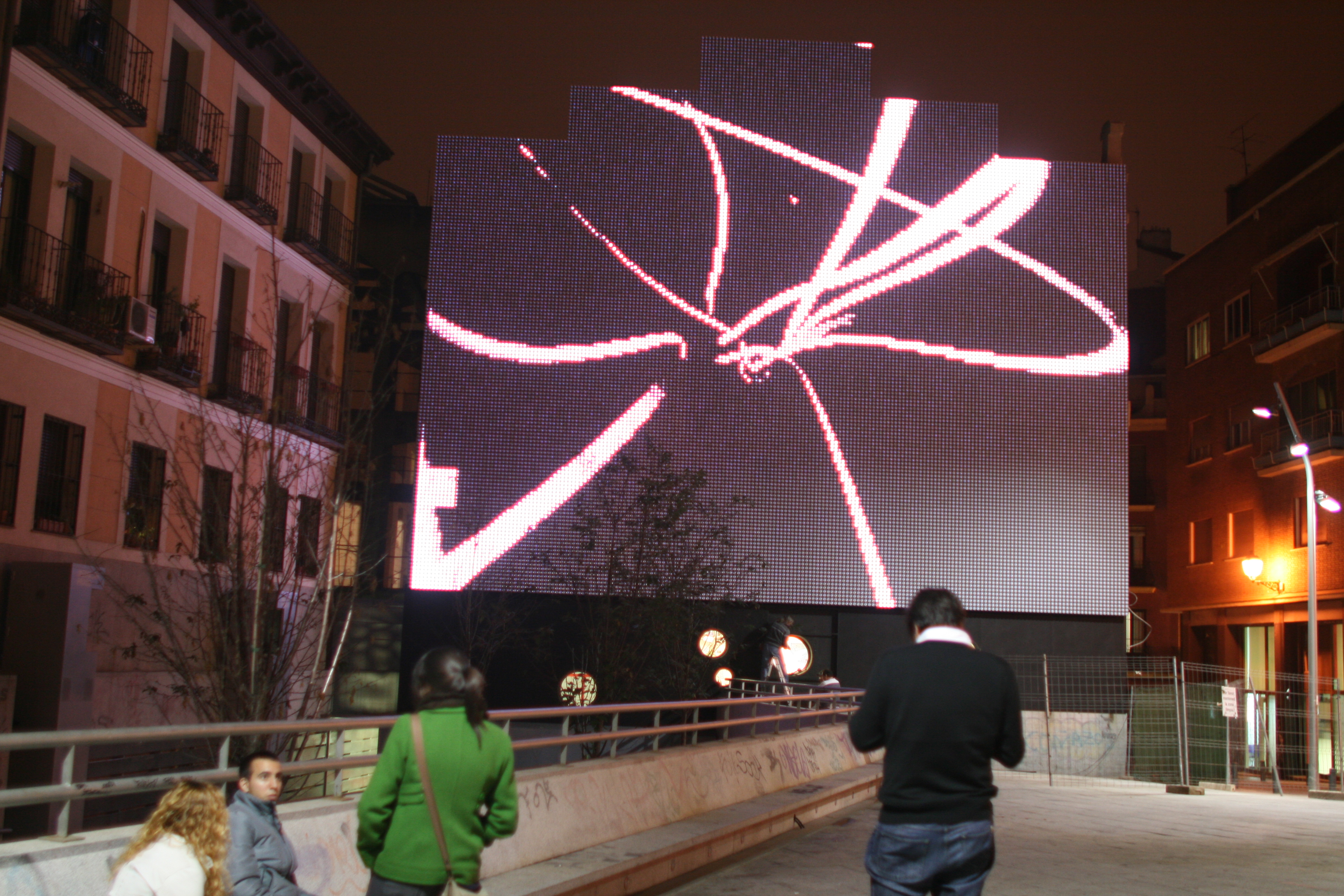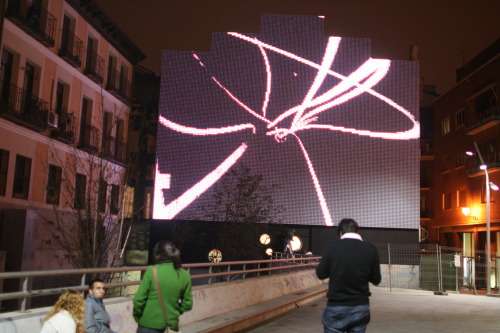Open Up workshop - projects for the digital facade of Medialab-Prado


Night image of the digital facade of Medialab-Prado during a test.
Open Up is a project production workshop for the digital facade of Medialab-Prado, that aims to explore the relationship with the urban space by opening production processes through different citizen participation strategies.
The workshop runs every day from February 9 through 23 on the following schedule:
Monday to Friday: 10 am to 8 pm
Saturdays: 11 am to 8 pm
Sundays: 11 am to 3 pm
Activities program*:
February 9
10:00 am - 2:30 pm: Introduction to the workshop and presentation of selected projects. [live streaming]
5:30 pm: Next part of the presentations [live streaming]
6:00 pm: Presentation by the tutor Casey Reas: Process / Form [+info] [live streaming]
7:00pm: Presentation by the tutor Víctor Viña: Digital Craft [+info] [live streaming]
February 10
10:00 am - 2:30 pm: Beginning of the workshop
5:30 pm: Presentation by the tutor Jordi Claramonte: Power to the (working class) LunchBox [+info] [live streaming]
6:15 pm: Lecture by Erkki Huhtamo: An Archaeology of Tall Media [+info] [live streaming]
7:15 pm: Roundtable with tutors and participants at the workshop [+info] [live streaming]
February 12
7:00pm: Collaborators' projects' presentation (English or Spanish without translation) [live streaming]
February 16
7:00 pm: Lecture by Jennifer Steimkamp: Orbits [+info] [live streaming]
7:45 pm: Presentation by tutor Chandler Mcwilliams: Repetition Repetition [+info] [live streaming]
February 23
6:00 pm: Final presentation of the results of the workshop. [live streaming]
*Translation by AICE Asociación de Intérpretes de Conferencia España
Tutor's approach
"Conventional public art tended to be defined as an aesthetic object related to the specific physical location where is destined to be. In contrast, the emerging public art practices from the 90´s constituted of interventions in the public domain that included the process of discussion, the creation of a will and the construction of a project for a community, which will house subsequent work that makes sense, this is what we want to talk about.
To talk about collaborative work should not lead us to think that what was before negotiated with an “authority”-like the installationof a doll on a horse- should now be necessarily agreed with a “community”, more or less misty, more or less unreachable.
The community with which we are going to collaborate might be there or might not be there. Even we might have to build it. Maybe we, the artists, are part of this community and did not realized.
Working in a public space-as MediaLab Prado´s screen does- implies to assume a new dimension in our work: the political and social articulation of a community, or half a dozen of them, of communities that exist or that are newly created.
So, we could portray ourselves and assume that what we call “collaborative art” is the process in which a group of people build the specific conditions for an environment with a particular freedom. This is possible by producing a homogeneous environment with a certain approach to relations, which in the case of a public intervention, as we mentioned, it will probably have consequences in the articulation of a community, previously existent or capable of being created around our intervention." By Jordi Claramonte
"Developing a framework for an open digital façade allows us to interrogate the life of the city from a multiplicity of scales. At the cellular level, the people in the city, moving through the city; city as system and background for our daily lives. We also have the city as an individual, as a whole in and of itself, living and growing as an organism. Both of these scales present interesting questions. How will an open digital façade alter the flow of people in the city? What new ways of acting will emerge from the affordances it provides? How can a protocol be developed to facilitate the creation of thriving micro-publics? As the mobile phone has changed the life of the individual, how can this open façade change the city? Here we are presented an opportunity to test these questions experimentally, through rapid iterative prototyping; and in so doing, we can generate new problems that further redefine the meaning of city, space, public, and façade." By Chandler McWilliams
"I'm fascinated with the public screen as a platform for diverse types of expression. Like public-access television and public radio, I imagine it to be programmed in diverse ways for many audiences. The content may change from hour to hour, night to night, season to season. For example, participatory games that turn the Plaza into an area, tools that allow children to make animated stories and present them, ambient environments that create a mood, augmented performances that envelop the Plaza, etc. I think the beauty of this opportunity to experiment and explore many ideas openly and publicly and to see what resonates. To make quick prototypes and discover what works, rather than guessing. As an outsider to Madrid, and the neighborhood, I don't have insight into what is needed, but I have many ideas to explore. " By Casey Reas
"The integration of open systems of visualization in public space offers opportunities to explore new possibilities including the interaction of the people living in the city with digital media. The combination of these systems with computer physical tools, mobile devices and the creation of technological artifacts capable of communicating can generate platforms for the transmission of information, for games, for collaboration, for the creation of social capital and for the expression of individual and collective interests.
Therefore, it is necessary to consider new strategies of intervention that can be applied in the context of the city considering the specific nature of each public space, taking the semantics of singular objects present in each location as a reference and proposing new models of integration that can generate hybrid spaces that stand between the physical and the virtual, between the analogical and the digital and between real and fictitious.
The core of the workshop will be focused in the conceptualization and visualization of possible systems that can integrate Madrid’s public space with the installation Led Action Screen. Support will be offered for the development of platforms with sensors, actuators, controllers, radio frequency communication, security systems, wearables, obsolete devices, urban furniture and other elements that allow the creation of proposals that bring to the contents of the installation a tangible side focusing in the people’s presence.
The elements used will be mainly open hardware tools though an interactive working process that allows the production of functional prototypes in the workshop." By Víctor Viña



 Medialab-Matadero Madrid
Medialab-Matadero Madrid